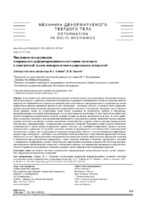Численное исследование напряженно-деформированного состояния заготовки в контактной задаче поверхностного дорнования отверстий

Date
2021Publisher
Another Title
Numerical Study of Stress-Strain State of Workpiece in Contact Problem of Surface Mandrel Drilling
Bibliographic entry
Сивцев, Н. С. Численное исследование напряженно-деформированного состояния заготовки в контактной задаче поверхностного дорнования отверстий = Numerical Study of Stress-Strain State of Workpiece in Contact Problem of Surface Mandrel Drilling / Н. С. Сивцев, В. В. Тарасов // Наука и техника. – 2021. – № 3. – С. 259-267.
Abstract
В последние годы экономический фактор играет все более важную роль при выборе технологий изготовления деталей машин с заданными значениями нормируемых параметров геометрической точности и качества рабочих поверхностей. Применительно к процессам поверхностного пластического деформирования это проявляется в поиске эффективных приемов управления трением в паре «инструмент – заготовка», которое, в конечном итоге, определяет картину распределения и величину напряжений и деформаций в заготовке и инструменте. Получить строгое аналитическое решение задачи по установлению связи между условиями на поверхности, трением и напряженно-деформированным состоянием контактируемых тел не представляется возможным. В этой связи на передний план выходит построение математических моделей, решение которых возможно численными методами. В статье приводятся результаты численного исследования (вычислительного эксперимента) конечно-элементной модели деформирования заготовки в различных условиях контактного взаимодействия и трения одним из методов поверхностного пластического деформирования – поверхностным дорнованием отверстий. Критерием оценки условий контактного взаимодействия и трения выбран коэффициент трения. Показано, что изменение коэффициента трения в процессе поверхностного дорнования не оказывает заметного влияния на формирование поля напряжений в деформируемой заготовке как в осевом, так и в радиальном и окружном направлениях. Вместе с тем при повышении коэффициента трения в паре «инструмент – заготовка» и соответственно силы механического сопротивления деформации заготовки наблюдается их рост. Вычислительным экспериментом подтверждено наличие внеконтактных деформаций заготовки и инструмента при поверхностном дорновании, а также снижение величины остаточных деформаций в заготовке с уменьшением коэффициента трения. Оценка баланса перемещений контактных поверхностей заготовки (внутренняя поверхность обрабатываемого отверстия) и инструмента показала, что деформации инструмента в упругой области могут привести к существенному снижению реального натяга поверхностного дорнования отверстий.
Abstract in another language
In recent years, the economic factor has played an increasingly important role in the selection of technologies for manufacturing machine parts with specified values of normalized parameters of geometric accuracy and quality of working surfaces. As applied to surface plastic deformation processes, this is noticeably manifested in the search for effective friction control methods in the “tool – workpiece” pair, which ultimately determines the distribution pattern and the magnitude of stresses and strains in the workpiece and the tool. It is not possible to obtain a rigorous analytical solution to the problem of establishing a connection between surface conditions, friction, and the stress-strain state of the contacted bodies. In this regard, the construction of mathematical models comes to the fore, the solution of which is possible by numerical methods. The paper presents the results of a numerical study (computational experiment) of a finite-element model of workpiece de-formation under various conditions of contact interaction and friction by one of the methods of surface plastic deformation – surface mandrel drilling. The friction coefficient has been chosen as the criterion for assessing the conditions of contact inter-action and friction. It is shown that a change in the friction coefficient in the process of surface mandrel has no noticeable effect on the formation of a stress field in the deformable workpiece both in the axial, and in the radial and circumferential directions. At the same time, with an increase in the value of the friction coefficient in the “tool – workpiece” pair and with the associated increase in the force of mechanical resistance to deformation of the workpiece, their growth is observed. A computational experiment has confirmed the presence of non-contact deformations of the workpiece and tool during surface mandrel drilling, as well as as a decrease in the value of residual deformations in the workpiece with a decrease in the coef- ficient of friction. Balance assessment of contact surface displacements in the workpiece (the inner surface of the hole to be machined) and the tool (mandrel) has shown that the deformations of the tool in the elastic region can lead to a significant decrease in the real tightness of surface mandrel drilling.
View/
Collections
- № 3[10]
